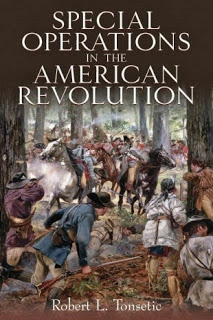"Special Operations in The American Revolution" by Robert Tonsetic tells nine stories of battles or campaigns during the American Revolutionary War. In each case, the American colonist used unconventional warfare.
Experience the battles/campaigns of the American Revolutionary War. Learn the background of the principal leaders. See American know-how demonstrated by the army, navy and marines in their operations.
My favorite chapters were one and eight. "The Capture of Fort Ticonderoga" is the title and story of chapter one. It tells of Ethan Allen's leadership. "The Whaleboat Wars" is the title of chapter eight. It includes the story of Benjamin Tallmage.
The author is a very good story teller. He brings the events to life through the stories of the participants.
The book fills a void in the literature of the American Revolution.
Added bonuses are the book's bibliography. It is excellent. The operational maps and photos also compliment the narrative.
Casemate Publishing published "Special Operations in The American Revolution" by Robert Tonsetic. It is a must addition to the library of every military historian as well as students of the American revolutionary War.
Dr. Tonsectic has crafted an exciting book.
 Jimmie Aaron Kepler is a novelist, poet, book reviewer, and award-winning short story writer. His work has appeared in over twenty venues, including Bewildering Stories and Beyond Imagination. When not writing each morning at his favorite coffee house, he supports his writing, reading, and book reviewing habit working as an IT application support analyst. He is a former Captain in the US Army. His blog Kepler's Book Reviews was named a 100 best blogs for history buffs in 2010. You can visit him at http://www.jimmiekepler.com.
Jimmie Aaron Kepler is a novelist, poet, book reviewer, and award-winning short story writer. His work has appeared in over twenty venues, including Bewildering Stories and Beyond Imagination. When not writing each morning at his favorite coffee house, he supports his writing, reading, and book reviewing habit working as an IT application support analyst. He is a former Captain in the US Army. His blog Kepler's Book Reviews was named a 100 best blogs for history buffs in 2010. You can visit him at http://www.jimmiekepler.com.






